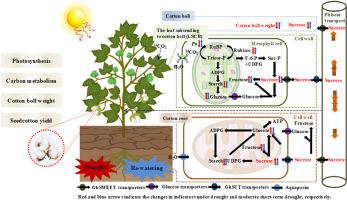Drought-induced change in carbon allocation between cotton root and the leaf subtending to cotton boll determines boll weight formation
IF 5.7
2区 生物学
Q1 PLANT SCIENCES
引用次数: 0
Abstract
Drought often has an effect on cotton yield by changing carbon metabolism during the flowering and boll-forming stage. In order to investigate how drought influences carbon allocation between cotton root and the leaf subtending to cotton boll (LSCB), thereby affecting boll weight formation, the pot experiment was conducted from 2021 to 2022 by using three drought levels with soil relative water content (SRWC) of (75 ± 5)% (CK), (60 ± 5)% (moderate drought), and (45 ± 5)% (severe drought) and three drought durations of 10, 24, and 38 days. Along with 13C isotope labeling, drought significantly inhibited the LSCB photosynthetic performance, leading to a reduction in photosynthetic carbon input and decreased 13C accumulation in both cotton root and LSCB. In LSCB, drought increased sucrose synthase (SuSy) and sucrose phosphate synthase (SPS) activities but decreased invertase (Acid-INV, Alkaline-INV) activities, leading to sucrose accumulation and restricted carbon transport to cotton boll. In cotton root, drought enhanced SuSy, SPS, and invertase activities, increasing soluble sugar (e.g., sucrose, glucose, fructose) for drought tolerance. Increased root carbon demand further limited carbon supply to cotton boll. Notably, re-watering after 10-day moderate drought rapidly restored LSCB photosynthesis, optimized carbon allocation, mitigated carbon competition between root and cotton boll, and consequently promoted boll weight recovery and maintained seedcotton yield. These results indicate that drought-induced change in carbon allocation between cotton root and LSCB, highlighting the beneficial effect of timely re-watering after moderate short-term drought on yield, thus providing new theoretical insights for optimizing cotton water management strategies.

干旱引起的棉花根与棉铃叶片间碳分配的变化决定了棉铃重的形成。
干旱通常通过改变棉花开花和结铃阶段的碳代谢来影响棉花产量。为研究干旱如何影响棉花根与棉铃叶片之间的碳分配,从而影响棉铃重的形成,本试验于2021 - 2022年进行了盆栽试验,采用土壤相对含水量(SRWC)为(75±5)% (CK)、(60±5)%(中度干旱)和(45±5)%(重度干旱)3种干旱水平,干旱持续时间分别为10、24和38 d。13C同位素标记表明,干旱显著抑制了LSCB的光合性能,导致棉花根和LSCB的光合碳输入减少,13C积累减少。干旱使蔗糖合酶(SuSy)和蔗糖磷酸合酶(SPS)活性升高,而转化酶(酸性inv、碱性inv)活性降低,导致蔗糖积累,限制了碳向棉铃的转运。在棉花根系中,干旱增强了SuSy、SPS和转化酶的活性,增加了可溶性糖(如蔗糖、葡萄糖、果糖)的耐旱性。根系碳需求的增加进一步限制了棉铃的碳供应。中度干旱10 d后再浇水可迅速恢复LSCB光合作用,优化碳分配,减轻根与棉铃之间的碳竞争,从而促进铃重恢复,维持棉籽棉产量。这些结果表明,干旱导致棉花根系与LSCB间碳分配发生变化,突出了短期中度干旱后及时补水对产量的有利影响,为优化棉花水分管理策略提供了新的理论见解。
本文章由计算机程序翻译,如有差异,请以英文原文为准。
求助全文
约1分钟内获得全文
求助全文
来源期刊
CiteScore
11.10
自引率
3.10%
发文量
410
审稿时长
33 days
期刊介绍:
Plant Physiology and Biochemistry publishes original theoretical, experimental and technical contributions in the various fields of plant physiology (biochemistry, physiology, structure, genetics, plant-microbe interactions, etc.) at diverse levels of integration (molecular, subcellular, cellular, organ, whole plant, environmental). Opinions expressed in the journal are the sole responsibility of the authors and publication does not imply the editors'' agreement.
Manuscripts describing molecular-genetic and/or gene expression data that are not integrated with biochemical analysis and/or actual measurements of plant physiological processes are not suitable for PPB. Also "Omics" studies (transcriptomics, proteomics, metabolomics, etc.) reporting descriptive analysis without an element of functional validation assays, will not be considered. Similarly, applied agronomic or phytochemical studies that generate no new, fundamental insights in plant physiological and/or biochemical processes are not suitable for publication in PPB.
Plant Physiology and Biochemistry publishes several types of articles: Reviews, Papers and Short Papers. Articles for Reviews are either invited by the editor or proposed by the authors for the editor''s prior agreement. Reviews should not exceed 40 typewritten pages and Short Papers no more than approximately 8 typewritten pages. The fundamental character of Plant Physiology and Biochemistry remains that of a journal for original results.

 求助内容:
求助内容: 应助结果提醒方式:
应助结果提醒方式:


